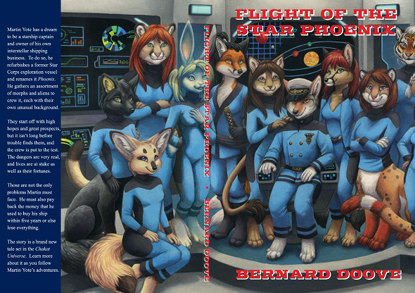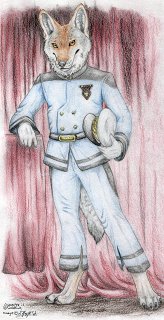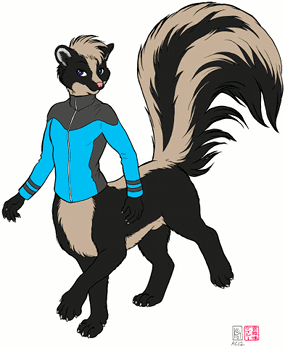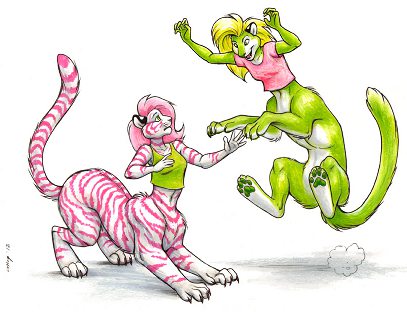Review: 'Flight of the Star Phoenix', by Bernard Doove
 Six of Bernard Doove’s last seven books have been set in his 24th century “Chakat Universe”. So is Flight of the Star Phoenix, but with a difference. These are the adventures of the starship Phoenix, captained by a coyote morph and crewed by just about every species in Doove’s universe. Chakats are included in the mix, although this is not really a chakat story.
Six of Bernard Doove’s last seven books have been set in his 24th century “Chakat Universe”. So is Flight of the Star Phoenix, but with a difference. These are the adventures of the starship Phoenix, captained by a coyote morph and crewed by just about every species in Doove’s universe. Chakats are included in the mix, although this is not really a chakat story.
This novel is really an assembly of the thirteen Phoenix stories that have appeared on Doove’s “Chakat’s Den” website. They are called chapters, but they read more like a collection of separate short stories. Although the book has an overall theme – in 2332-2337, the interstellar freighter Phoenix must prove itself financially profitable by its fifth anniversary or go out of business – it reads more like thirteen separate adventures during those five years, with individual beginnings, plots, climaxes, and conclusions. Fans of short, episodic starship adventures will enjoy this more than the fans of long novels. And the fans of Doove’s regular chakat tales will be very satisfied with it.
CreateSpace, November 2012, trade paperback $21.95 (388 pages). Illustrated.
The fans of Doove’s regular chakat tales will also be familiar with his array of pronouns for the different species: “his” and “her” for the humans, Caitians, and other two-sexed species; “hir” and “shi” for the chakats, foxtaurs, and other hermaphrodites; and “hy” and “hym” for the skunktaurs. The reader will get accustomed to the differences quickly.
Martin Yote is a 21-year-old coyote morph, the youngest son of rich industrialist Arthur Yote. Yote père has customarily given each of his children a large bequeathal on his or her 21st birthday to show their potential:

(A flashback to three years before.) Martin’s second brother’s birthday was the excuse for this family get-together, having just turned twenty-one and received his father’s bequeathal. Like his sister and elder brother, Hank now had to decide how to use that money to set himself up in a business, or buy into an existing one with the goal of making back that money and turning it into a profitable success. It was a generous bequeathal, and an excellent head-start for any young person with the talent and drive to make it a going concern. There was only one catch, but it was a big one – they had to make back that money and show a specific amount of profit without the slightest extra help from their wealthy industrialist father, and in a maximum of five years. If they failed, they had to give up the business and take a job in their father’s company, starting at the bottom. It was excellent incentive. (p. 9)
Each of Martin’s siblings chose a safe commercial career that their father approved of. Martin is the only one to strike out against his father’s advice:
‘That sounds like a good compromise. I look forward to seeing the results.’ Then their father looked in Martin’s direction. ‘And while we’re on the subject, have you got any idea yet what you’re going to aim for? You’ve only got a year and a half before you complete school and have to decide on tertiary studies.’
‘I do have a goal, actually,’ Martin replied. ‘I want to buy a starship and start my own independent shipping company.’
Yote Senior frowned. ‘This is a joke, right? Shipping is a mug’s game. Do you know how many independents fail in their first year of business? Do you know that most struggle with debt for many years, and maybe never make any decent money? Only the big shipping companies make money at that game, and they have the benefit of huge infrastructure and other advantages. You’d be better off buying into one of their subsidiaries.’
‘No, I intend to be my own boss. I could never be that if I do it your way. Besides, I want to travel, not sit behind a desk.’ (pgs. 10-11)
 In the first chapter, “Crew Review”, Martin buys his space freighter despite his father’s disapproval. This only takes up pages 7 to 13; the remainder of the 72-page chapter introduces at length the other regular characters: Heywood Baxter (human) and Menalippe, his ferret morph lover; Ceres, a Stellar Foxtaur, and Danson, hir normal foxtaur lover; R’Murran (Caitian) and his four wives; Risha de Mar, a four-armed cougar morph; Hotfoot, Burningbright, and Zelkie, three chakat lifemates with their three adolescent kits; Anastasiya and Valentina Tartikova, two mated Russian Amur Tiger morph hermaphrodites; and Bethany Oakwood, a grey fox morph ex-Star Fleet officer. These are the initial crew of the stellar freighter Phoenix; others will join later.
In the first chapter, “Crew Review”, Martin buys his space freighter despite his father’s disapproval. This only takes up pages 7 to 13; the remainder of the 72-page chapter introduces at length the other regular characters: Heywood Baxter (human) and Menalippe, his ferret morph lover; Ceres, a Stellar Foxtaur, and Danson, hir normal foxtaur lover; R’Murran (Caitian) and his four wives; Risha de Mar, a four-armed cougar morph; Hotfoot, Burningbright, and Zelkie, three chakat lifemates with their three adolescent kits; Anastasiya and Valentina Tartikova, two mated Russian Amur Tiger morph hermaphrodites; and Bethany Oakwood, a grey fox morph ex-Star Fleet officer. These are the initial crew of the stellar freighter Phoenix; others will join later.
Doove makes the reasonable point that the first five years of the Phoenix’s cruises are not all crises; this novel just concentrates on the dramatic incidents. Still, by featuring only the dramas, Flight of the Star Phoenix gives the impression that it is all drama. Chapter 2 tells how the individuals of the crew settle into working smoothly together, and adds Penny Lane, a mouse morph stowaway, and Loander and Presaith, two adolescent Faleshkarti (they look like fennec morphs) hermaphrodites, to the crew. In chapter 3, space pirates attempt to take over the Phoenix. In chapter 4, false charges are made against Martin and his crew. The time taken to disprove them throws the Phoenix off-schedule and seriously jeopardizes its profitability. In chapter 5, the Phoenix unwittingly carries a potentially galaxy-wide deadly plague, and another new crew member is added. In chapter 6, a most unusual crew member is added, and the Phoenix is docked on the Hesperia asteroid/space station when a runaway giant spaceship is about to destroy it.
In chapter 7 … well, you get the idea.

There is much drama and seldom a dull moment in Flight of the Star Phoenix, including – considering that five years aboard the Phoenix is covered – the occasional soap-operaish dispute among the crew. Some of the crew are killed and, with considerable pathos, replaced. See Kacey Miyagami’s wraparound cover for a group portrait.
As usual with Doove’s fiction that has appeared on his website first, the stories are profusely illustrated by over a dozen artists. Unfortunately, the illustrations that appear in full color in the “Chakat’s Den” are in black-&-white in this book.
Considering Doove’s usual “Chakat Universe” fiction, Flight of the Star Phoenix has very little sex. Chapter 12, though, is set on the home planet of the Faleshkarti, where adults are subject to an irresistible biological daily sexual urge. This is presented clinically and tastefully rather than voyeuristically, showing how a stable civilization might develop under such circumstances, but there is still considerable blatant sex. The reader is warned.
An annoyance or an error? Anastasiya and Valentina Tartikova, the two Amur Tiger morphs, speak with thick Russian accents. Everyone else speaks in regular current American/Australian/British English. Is the reader to assume that everyone throughout the galaxy speaks 20th-21st-century English except the Russians on Earth? Or that the various galactic languages of the 24th century have been translated into 21st-century English for the reader’s convenience – except for Russian? Either way, this feels like a jarring inconsistency rather than convincing authenticity. But aside from this, and the episodic format which prevents any novel-length drama from developing, Flight of the Star Phoenix is satisfying space opera. Recommended.
About the author
Fred Patten — read stories — contact (login required)a retired former librarian from North Hollywood, California, interested in general anthropomorphics
Comments
Post new comment